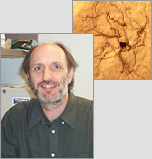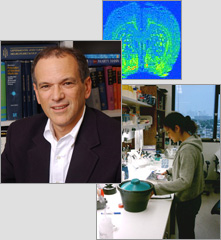Project 1
Project Leader: Paul Greengard, Ph.D.

Antipsychotics that antagonize G-protein coupled, dopaminergic receptors alleviate the symptoms of schizophrenia. This Conte Center Project explores how typical and atypical antipsychotic drugs exert their actions via distinct molecular changes in cell populations that impinge upon and participate in striatal signaling. By identifying what these changes are, we will identify common signaling pathways that are linked to the therapeutic effects of antipsychotic drugs. Project 1 focuses on striatal cell-specific changes in mRNA translation induced by antipsychotic drug administration.
Project 2
Project Leader: Nathaniel Heintz, Ph.D.
Hypofunction of cortico-basal ganglia circuits has been hypothesized to underlie some of the debilitating cognitive deficits and negative symptoms that are seen in schizophrenic patients. Antipsychotics are thought to mediate some of their therapeutic effects by normalizing this activity. However, the precise cell populations and the molecular changes involved in this response are still not fully understood. In Project 2 of this Conte center application, we hypothesize that cell-type specific changes in neurons projecting from the frontal cortex to the basal ganglia occur in response to typical and atypical antipsychotic drugs. To test this hypothesis, we will make use of a novel mRNA translational profiling approach.
Project 3
Project Leader: Angus C. Nairn, Ph.D.

Project 3 will address the major theme of the Conte center "Identification of cell type-specific actions of antipsychotic drugs" by taking primarily biochemical approaches to characterize key signaling proteins believed to be involved in the effects of antipsychotic drugs on specific aspects of neuronal function within corticostriatal circuits. In addition, Project 3 will elucidate the role of DARPP-32's nuclear function in the actions of antipsychotic drugs. Project 3 will also contribute biochemical expertise to ongoing studies by the other projects.
Project 4
Project Leader: Eric J. Nestler, Ph.D./M.D.

There is growing evidence that alterations in gene expression contribute to the long-lasting effects of antipsychotic drugs on the brain. Project 4 contributes importantly to our understanding of the molecular actions of antipsychotic drugs by examining these phenomena at the chromatin level, and by thereby providing novel insight into the molecular basis of antipsychotic drug action. Project 4 will characterize global changes in histone modifications induced by chronic antipsychotic drug exposure within striatal and prefrontal cortical regions of brain. These studies will advance our understanding of antipsychotic drug action, and provide novel approaches for the development of new drugs with improved efficacy and side effect profiles.
Project 5
Project Leader: D. James Surmeier, Ph.D.
Prolonged treatment with antipsychotics 'remodels' circuits of the prefrontal cortex and striatum, ameliorating the symptoms of the disease. Our central hypothesis is that this remodeling depends upon the ability of antipsychotics to trigger cell-type specific adaptations in the synaptic connectivity, dendritic architecture and intrinsic excitability of striatal and cortical neurons. Dysregulation of these key sub-cellular regions is likely to be a central factor in schizophrenia and provides an obvious linkage to glutamatergic determinants in the disease. Project 4 5 will utilize electrophysiological, pharmacological and molecular strategies to elucidate how antipsychotics and antipsychotic-sensitive receptors influence dendritic electrogenesis, synaptic integration and plasticity in functionally relevant subpopulations of striatal and PFC neurons.
